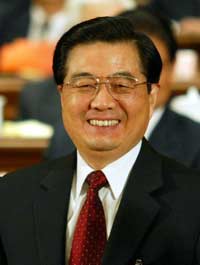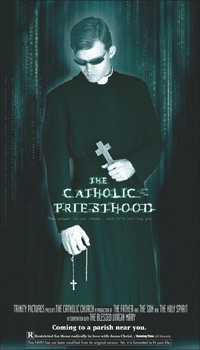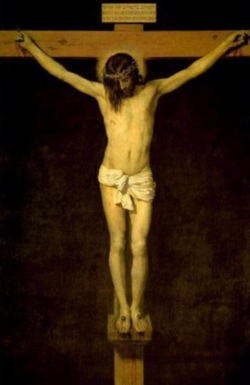
Friend PT preached this on last dim Good Friday morning at Berkeley Seminary.
It was powerful. “Let us see if his words are true, and let us test what will happen at the end of his life.”
How many times, in the Gospels, when Jesus starts to say something, does he begin with the words, “Truly, I tell you”?
“Truly, I tell you, if you have faith the size of a mustard seed, you will say to this mountain, ‘Move from here to there,’ and it will move; and nothing will be impossible for you.”...“Truly, I tell you, whoever does not receive the kingdom of God as a little child will never enter it.”...“Truly, I tell you, today you will be with me in paradise.”..."Truly, I tell you, unless you eat the flesh of the Son of Man and drink his blood, you have no life in you. Those who eat my flesh and drink my blood have eternal life, and I will raise them up on the last day.”
All four of the evangelists—Matthew, Mark, Luke and John—are agreed: Jesus claims to speak truly. But of the four, it is John who writes most about truth, who depicts Jesus saying, “Truly I tell you,” the most—and it is John who has Jesus going one step further: “I am the way, and the truth, and the life.” In John’s gospel, Jesus does not just speak truly—Jesus is truth, the true Word of God made flesh in the world.
“Let us see if his words are true, and let us test what will happen at the end of his life.”
If Jesus speaks truly—if he himself is truth—how can his words be tested? What standard can be brought to measure his claims? Is there another, competing truth that trumps the truth of Jesus? Only if Jesus speaks falsely is there a truth that can be brought against him, that will prove him to be a fraud and a liar. If Jesus speaks truly—if he is, indeed, the truth—there is no truth beyond himself that could challenge or test him. So how then, is he to be tested? How will we see if his words are true? How can we prove that he is a liar, a deceiver who will lead us astray? How can we rid ourselves of this inconvenient man, this righteous man—the very sight of him is a burden to us!
“Let us test him with insult and torture. Let us condemn him to a shameful death.”
If we cannot defeat him with truth, then there are other ways, easier ways really. We can beat him and mock him, belittle him, dress him up in robes and a crown, make a spectacle of him: “Hail, King of the Jews!” We can make him small and silly, flog him till he can barely stand, watch him bleed, just like we do. He’s no different from us, really, he’s just a man—just one man, and there are many of us. There are enough of us to do away with him. Truth or no truth, it doesn’t matter—he will die like any other man.
“Here is your King! Shall I crucify your King?”
What do we do in the face of an inconvenient truth? What happens when the truth confronts us with a reality that is painful and unpleasant, when it questions our lives and the ways we’re living them; ways we really like, ways that we don’t want to give up? How do we justify ourselves; how do we evade the truth; how do we make it go away?
“Away with him! Away with him! Crucify Him!”
Truly, it’s all very easy. The best way to stifle the truth is to deny that truth is even possible. During Jesus’ inquisition, Pilate asks, “What is truth?” This is the first step toward dispensing with truth: ask what it is in a dismissive way, question whether we can ever really know truth in the first place. Ask a philosopher about how to define truth and you’ll hear a lot about coherence theories, correspondence theories, pragmatist theories, minimalist theories—but you won’t hear a definitive answer to your question. Truth is subtle and difficult to grasp; it’s a tenuous, fragile thing, easy to call into question, easy to dismiss when it’s convenient. And what are you left with, once you’ve convinced yourself that the quest for truth is an impossible task, far too difficult to bother with? What do you put in the place of truth?
Pilate has the answer: in the absence of truth, you have power. Pilate says to Jesus, “Do you not know that I have power to release you, and power to crucify you?” In the vacuum left after the death of truth, there’s lots of room for power to play. There’s a whole mess of degenerate post-modern, post-structuralist, post-colonial, post-whatever theory that wants to say just that: there’s no such thing as truth—truth is just a mask for power. And there is, ironically, a certain measure of truth in this kind of thinking: we sinful creatures do try to claim truth as a way of justifying how we use power. But if we’re going to get away with it, we have to get rid of the one who is the Truth: we have to crucify him.
And once we have discredited, humiliated, and killed the Truth, we are free to make our own truth. The chief priests quibble with Pilate about the inscription over Jesus’ head: “Do not write ‘The King of the Jews,’ but ‘This man said, I am King of the Jews.’” And what is Pilate’s answer? “What I have written I have written.” The priests and Pilate both want to make their own truth, the truth that is most convenient for them, that serves their interests best. Neither inscription is quite right, but Pilate has the power to make his stick: “What I have written I have written.” Truth doesn’t matter; the truth can be met with power, it can be changed with power. “Do you not know that I have power to crucify you?” Isn’t that exactly what the Cross is: Power set against Truth?
Good Friday is the day that Power clashes with Truth. And what happens? Power wins—the Truth dies. “He said, ‘It is finished.’ Then he bowed his head and gave up his spirit.”
“Let us test him with insult and torture, so that we may find out how gentle he is, and make trial of his forbearance.”
How much can he take? How far can we push him? How many lashes with the whip, how many blows about his head—the thorns digging into his brow—how many hours on the Cross? How many sins can we heap on him, how many evil deeds can we make him witness, how much hurt can we inflict on each other while he looks on? How long will he suffer our wickedness to continue, how long will he tolerate the pollution of his creation, how long before his mercy is exhausted and his gentle nature gives way to wrath, a wrath we know is there, the wrath we know we deserve?
He takes it all. Everything that the world can throw at him, every drop of hatred and rebellion and falsehood is wrapped up in those two hard wooden beams that twist his body into shapes that should never be, and he takes it all, even unto death. We killed him, yes, but did we really think we could break him—that the one who resisted the Father of Lies would succumb to our temptation?
Despite the pain of the Cross, despite the burden he carries, he does not lash out: his gentleness holds; his mercy endures. He bears the weight of the world’s sin and he carries it down in death to the Pit. On the Cross, Jesus’ death swallows up death—evil is turned against evil, the Kingdom of Satan is divided against itself and cannot stand. And as the dead man’s arms are stretched out on the cross, the living God, who created heaven and earth, stretches himself out through that death into the realm of death and darkness, into the far reaches of sin that his divine nature abhors, and takes the whole sick, confused world into his loving embrace.
“Great things are they that you have done, O Lord my God! How great your wonders and your plans for us!”
The victory is won; the power of death is broken; the unchallenged reign of sin is over. And yet, the man is still dead; he is taken down from the Cross and laid in a tomb. His task is not fully completed—the world is still feverish from its illness—the people do not yet know and share the salvation he has worked for them. How will they learn of this Good News? Who will proclaim it to them? How will they know that they no longer need to wrestle each other with power? He must return to them, he must let them know that Truth lives, that they have not been abandoned to always pit power against power, one so-called truth against another.
He will return to them, and he will give them a gift to help them clear their minds. He will give them back the instrument of his death. He will give it back to them, not as it was before, not as a sign of the judgment of death, but as a sign of the judgment for truth. He will claim it as his own, sanctified and made glorious, a Holy Cross given to the world to show that the living Truth can bring great good out of great evil, that God redeems power and turns it to right ends.
The truth will still be elusive, and the temptation to replace it with misguided power will not fade away, especially for those who wish to follow him. Seeing through a glass darkly, they will always be tempted to seize a part of his truth and use it as a weapon against others, to substitute what they wrongly desire to be true for what it is actually true. They will say, “The scriptures are clear, Jesus wants this,” or they will say, “The Holy Spirit is doing a new thing” so that the Scriptures and the Holy Spirit say only what they want them to say. They will need to learn, again and again, to cast their truths before his Cross, to let their desire for power come under his judgment of truth. They will need to humble themselves as he was humble, to find their righteousness in his righteousness, and they will need to remember to pray in the brilliant shadow of His Cross. Let all of us gathered here, all of us so in need of Christ’s Cross, pray so now.




































